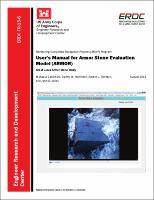Please use this identifier to cite or link to this item:
https://hdl.handle.net/11681/8481Full metadata record
| DC Field | Value | Language |
|---|---|---|
| dc.contributor | Environmental Laboratory (U.S.) | - |
| dc.contributor | Monitoring Completed Navigation Projects Program (U.S.) | - |
| dc.contributor.author | Zakikhani, Mansour, 1954- | - |
| dc.contributor.author | Harrelson, Danny W. | - |
| dc.contributor.author | Tillotson, Amber L. | - |
| dc.contributor.author | Ables, John D. | - |
| dc.date.accessioned | 2016-06-20T13:27:11Z | - |
| dc.date.available | 2016-06-20T13:27:11Z | - |
| dc.date.issued | 2015-08 | - |
| dc.identifier.uri | http://hdl.handle.net/11681/8481 | - |
| dc.description | Technical Report | - |
| dc.description | Abstract: Protecting entrances to navigation channels or other coastal areas requires evaluating maritime structures that often feature a surface layer of armor stones, such as rubble-mound breakwaters and jetties. Armor rocks are impacted by natural elements such as seasonal weather and repeated cycles of temperature, flowing water, wetting and drying, wave action, and freeze and thaw. The Armor Stone Evaluation (ARMOR) numerical simulation model consists of stone deterioration software developed to integrate field observations with numerical tools, and it provides an assessment of stone performance during the life of the rubble-mound structures. The ARMOR software has several numerical models that predict degradation as rocks are impacted by nature. The software includes a statistical technique (homogeneity index) to characterize rock heterogeneity. Two numerical approaches have been developed to calculate freeze-thaw cycles using long-term site weather data. The software also provides a model to estimate armor weight and thickness, minimum crest width, and number of armor units per unit of area. The calculation uses varying values for the seaward slope and wave height by application of the Hudson formula for rubble-mound structure stability. The degradation model relates laboratory results to modification of mass distribution and reduction at the project site. This report provides instructions for creating input data and running different options of the program. ARMOR software is distributed on CD or DVD and may be obtained from Dr. Mansour Zakikhani, U.S. Army Engineer Research and Development Center, Environmental Laboratory, 3909 Halls Ferry Road, Vicksburg, MS, 39180; (Mansour.zakikhani@usace.army.mil); phone 601-634-3806. | - |
| dc.publisher | Geotechnical and Structures Laboratory (U.S.) | - |
| dc.publisher | Engineer Research and Development Center (U.S.) | - |
| dc.relation | http://acwc.sdp.sirsi.net/client/en_US/search/asset/1045252 | - |
| dc.relation.ispartofseries | ERDC TR ; 15-6. | - |
| dc.rights | Approved for public release; distribution is unlimited. | - |
| dc.source | This Digital Resource was created in Microsoft Word and Adobe Acrobat | - |
| dc.subject | Stone deterioration | - |
| dc.subject | Type A Armor Stone | - |
| dc.subject | Freeze/thaw evaluation | - |
| dc.subject | Hudson Formula | - |
| dc.subject | Rubble-mound structures | - |
| dc.subject | Navigation channels | - |
| dc.subject | Computer programs | - |
| dc.title | User’s Manual for Armor Stone Evaluation Model (ARMOR) : Great Lakes Armor Stone Study | - |
| dc.type | Report | en_US |
| Appears in Collections: | Technical Report | |
Files in This Item:
| File | Description | Size | Format | |
|---|---|---|---|---|
| ERDC-TR-15-6.pdf | 5.13 MB | Adobe PDF |  View/Open |